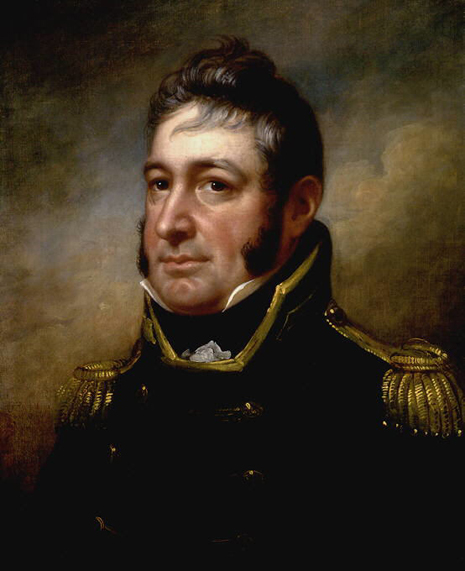The following post was originally written for “Face to Face,” a blog by the National Portrait Gallery in Washington, DC. To view the original post, follow this link.

As Constitution cleared Boston Light and met the first Atlantic swells, a tall man dressed in blue and gold paced the quarterdeck. He held in his hands the fates of all those on board. The sailors could be forgiven if they looked apprehensive when they thought of what the next few months might bring. Their captain enjoyed a less-than-brilliant reputation.
Born in Princeton, New Jersey, William Bainbridge (1774–1833) entered the fledgling United States Navy as a lieutenant in 1798. Years spent sailing on merchant voyages to Europe and the West Indies had honed his seamanship, and as the Quasi-War with France heated up, the Navy gave Bainbridge command of the 18-gun schooner Retaliation.
Unfortunately, during a cruise off Antigua, the little warship fell in with a French squadron and the young captain surrendered without firing a shot. To add to the ignominy, this was the very first ship lost by the United States Navy.
Exonerated for the defeat, he subsequently received command of the frigate George Washington. Tasked with carrying a cargo of tribute from the United States to the Dey of Algiers, Bainbridge once again found himself embroiled in an unhappy situation. The Dey, eager to curry favor with his superior in Constantinople, ordered Bainbridge to transport his embassy there in the George Washington; refusal on the part of the Americans would lead to open war. Adding insult to the humiliation, the Dey required the ship to sail under the Algerian flag.
At home, reactions to the situation were mixed, but in the end, Captain Bainbridge escaped with his career intact. American relations with the Barbary States of North Africa deteriorated, and Bainbridge returned to the Mediterranean in command of the frigate Philadelphia.
On October 31, 1803, as the Americans chased a Tripolitan ship into Tripoli Harbor, the Philadelphia ran aground on an unmarked shoal. All attempts to float it off proved futile, and as enemy gunboats swarmed around, Bainbridge reluctantly hauled down the American flag. The Tripolitans freed the ship and carried her into Tripoli, where Stephen Decatur subsequently destroyed her in a daring night raid. Philadelphia’s crew went straight into a Tripolitan prison.
After his release and return to the United States in 1805, Bainbridge was somehow, miraculously, cleared of negligence again. Yet his career ground to a halt in the peacetime navy. He went on furlough to try his fortune in the merchant fleet but returned from a foreign voyage as rumors of war began to grow.
In September 1812, he assumed command of Constitution from Captain Isaac Hull, who had just led the ship to victory over HMS Guerrière, and in October he sailed from Boston with orders to “afford protection to our trade & to annoy the enemy.”
Absolution for his past failures came on the afternoon of December 29,1812. Off the coast of Brazil, Constitution encountered HMS Java (47 guns) under the command of Captain Henry Lambert. Bainbridge put his seamanship to the test as the ships maneuvered to gain an advantageous position. Early in the action, a British shot shattered Constitution’s helm, leaving the ship temporarily out of control and embedding a piece of shrapnel in Bainbridge’s thigh.
Despite his wound, he stayed on deck to direct the action. The quick-firing American gun crews battered their opponent into submission, and the British ensign finally fluttered down about three-and-a-half hours after the first shots were fired.
When Constitution dropped anchor in Boston in February 1813, Americans everywhere hailed Bainbridge and his crew as heroes. Leading citizens in cities from Portland, Maine, to Washington, D.C., threw elaborate dinner parties for the captain and his officers, and bestowed valuable gifts of silver and gold. Congress authorized $50,000 worth of “prize money” to be distributed among the crew and ordered a commemorative medal struck—solid gold for Captain Bainbridge and silver for the other commissioned officers. Despite these awards, Bainbridge wrote to a friend that “the applause of my countrymen has for me greater charms than all the gold that glitters.”
Rembrandt Peale’s brush joined in the general ebullience. Peale captured the essence of his sitter, depicting him in his full dress uniform perfectly. The commodore’s eyes seem to sparkle with joy at his newfound fame.
According to an early biographer, “Com. Bainbridge . . . was six feet in height, and had a finely molded and muscular frame, which enabled him to endure any amount of fatigue. His complexion was rather fair, his beard dark and strong, his eyes black, animated, and expressive. His deportment was commanding, his dress always neat; his temperament was ardent and somewhat impetuous, though he could qualify it with the greatest courtesy and the most attractive amenity.”
Bainbridge’s naval career continued for another twenty-one years, until a bout of pneumonia laid him low. In his last hours “he called for his sword and pistols, . . . and ordered that all hands be called to board the enemy.” This time, he would only strike his flag to Death.
The Author(s)
Matthew Brenckle
Research Historian, USS Constitution Museum
Matthew Brenckle was the Research Historian at the USS Constitution Museum from 2006 to 2016.